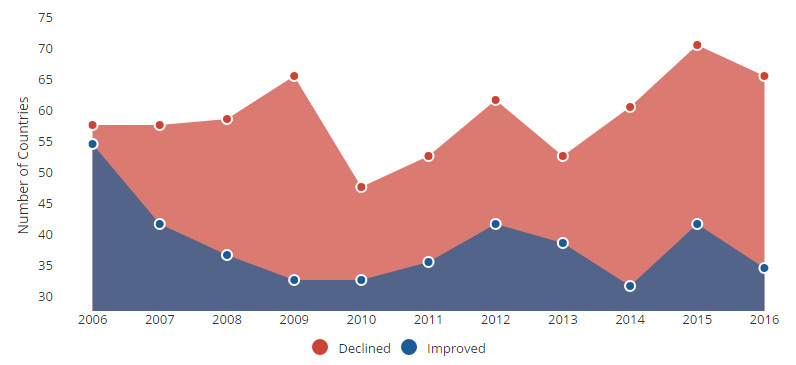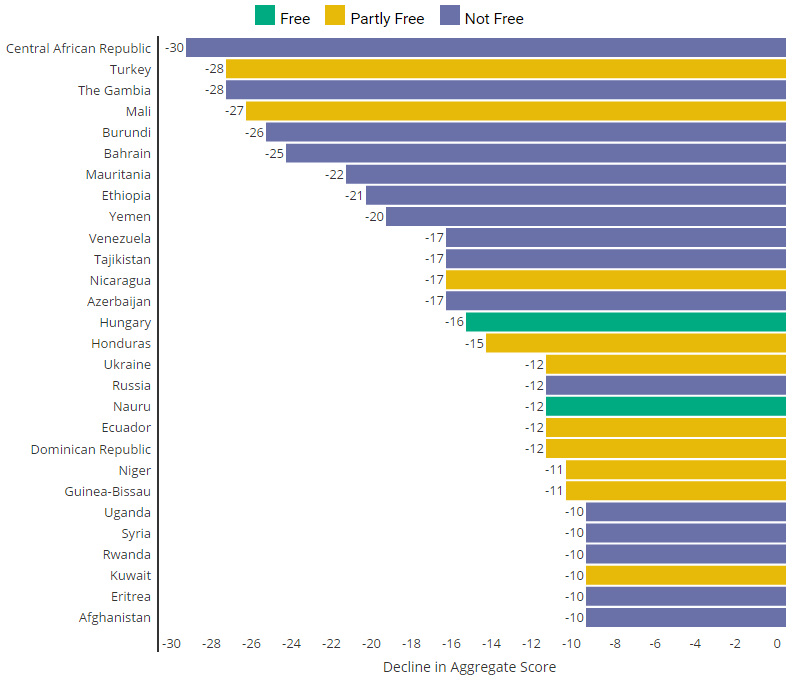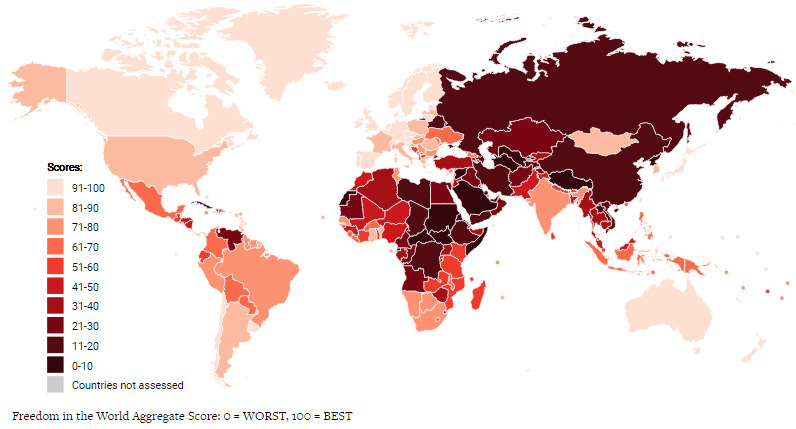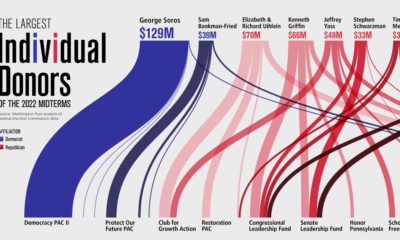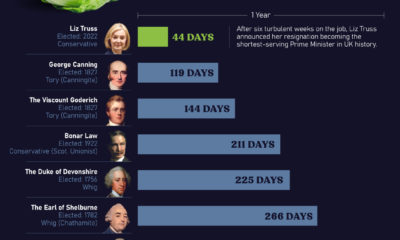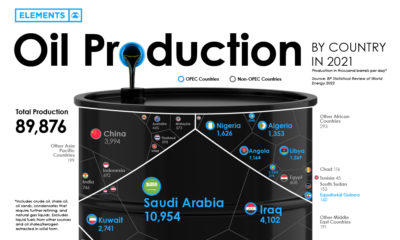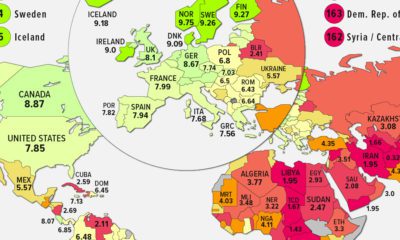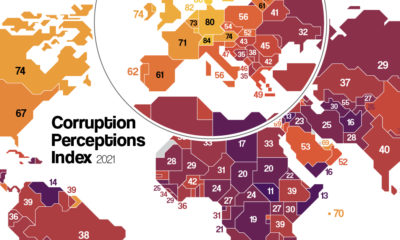As a result of these gains, wealth has increased exponentially, and world poverty is now at all-time lows. Life expectancy continues to improve in most countries, global literacy is near 90%, and there are well over 100 democracies throughout the planet. But not every positive trend can keep going forever. Sometimes things regress temporarily, only to be corrected later on. Other times things change more fundamentally – and that regression can be the beginning of a newer, long-term reality.
The Decline of Freedom: An 11-Year Trend
According to the Freedom in the World 2017 Report, which scores countries annually on various levels of freedom, there have been recent setbacks in political rights and civil liberties in a number of “Free” countries. These newest declines are partially the result of populist and nationalist forces making significant gains in democratic states. But Freedom House, the international watchdog organization that produces the annual report, says that this is not an isolated occurrence. In fact, based on their data and methodology, freedom has actually declined on a global basis for the last 11 years. Here are the aggregate gains and declines in freedom for each year – you can see that declines have been outweighing gains since 2006.
11 Years of Decline
While the trend is clear, the most worrying part is that the biggest aggregate declines happened in the two most recent years. Is that a coincidence, or is the decline of freedom accelerating? Here are the specific countries that have had the biggest declines in freedom over the last decade:
Largest Aggregate Declines Over the Last Decade
Countries like Yemen and Ethiopia, which are classified as “Not Free”, have lost further freedom. However, “Free” countries like Hungary or Nauru also lost 10 or more points in the index.
2016: Another Year of Setbacks
The biggest mover in 2016 was Turkey, a country that the Washington Post says is in a “permanent state of crisis”. A failed coup attempt, the assassination of a Russian ambassador, trouble in bordering Syria, and economic crises have accelerated the march to authoritarianism in the country – and it’s had a 15-point decline of freedom as a result, according to Freedom House.
Biggest Movers in 2016
Hungary and Poland are among the Western democracies that lost significant points in 2016, but the report also has its crosshairs on the United States for 2017. It notes the U.S. as a “country to watch” this year because of the Trump administration’s approach to civil liberties, as well as a potential redefinition of the United States’ role in the world. Here are where things stand as of now:
Map: World Freedom in 2017
For the whole report, which is a highly-recommended read, go here.
on Even while political regimes across these countries have changed over time, they’ve largely followed a few different types of governance. Today, every country can ultimately be classified into just nine broad forms of government systems. This map by Truman Du uses information from Wikipedia to map the government systems that rule the world today.
Countries By Type of Government
It’s important to note that this map charts government systems according to each country’s legal framework. Many countries have constitutions stating their de jure or legally recognized system of government, but their de facto or realized form of governance may be quite different. Here is a list of the stated government system of UN member states and observers as of January 2023: Let’s take a closer look at some of these systems.
Monarchies
Brought back into the spotlight after the death of Queen Elizabeth II of England in September 2022, this form of government has a single ruler. They carry titles from king and queen to sultan or emperor, and their government systems can be further divided into three modern types: constitutional, semi-constitutional, and absolute. A constitutional monarchy sees the monarch act as head of state within the parameters of a constitution, giving them little to no real power. For example, King Charles III is the head of 15 Commonwealth nations including Canada and Australia. However, each has their own head of government. On the other hand, a semi-constitutional monarchy lets the monarch or ruling royal family retain substantial political powers, as is the case in Jordan and Morocco. However, their monarchs still rule the country according to a democratic constitution and in concert with other institutions. Finally, an absolute monarchy is most like the monarchies of old, where the ruler has full power over governance, with modern examples including Saudi Arabia and Vatican City.
Republics
Unlike monarchies, the people hold the power in a republic government system, directly electing representatives to form government. Again, there are multiple types of modern republic governments: presidential, semi-presidential, and parliamentary. The presidential republic could be considered a direct progression from monarchies. This system has a strong and independent chief executive with extensive powers when it comes to domestic affairs and foreign policy. An example of this is the United States, where the President is both the head of state and the head of government. In a semi-presidential republic, the president is the head of state and has some executive powers that are independent of the legislature. However, the prime minister (or chancellor or equivalent title) is the head of government, responsible to the legislature along with the cabinet. Russia is a classic example of this type of government. The last type of republic system is parliamentary. In this system, the president is a figurehead, while the head of government holds real power and is validated by and accountable to the parliament. This type of system can be seen in Germany, Italy, and India and is akin to constitutional monarchies. It’s also important to point out that some parliamentary republic systems operate slightly differently. For example in South Africa, the president is both the head of state and government, but is elected directly by the legislature. This leaves them (and their ministries) potentially subject to parliamentary confidence.
One-Party State
Many of the systems above involve multiple political parties vying to rule and govern their respective countries. In a one-party state, also called a single-party state or single-party system, only one political party has the right to form government. All other political parties are either outlawed or only allowed limited participation in elections. In this system, a country’s head of state and head of government can be executive or ceremonial but political power is constitutionally linked to a single political movement. China is the most well-known example of this government system, with the General Secretary of the Communist Party of China ruling as the de facto leader since 1989.
Provisional
The final form of government is a provisional government formed as an interim or transitional government. In this system, an emergency governmental body is created to manage political transitions after the collapse of a government, or when a new state is formed. Often these evolve into fully constitutionalized systems, but sometimes they hold power for longer than expected. Some examples of countries that are considered provisional include Libya, Burkina Faso, and Chad.
